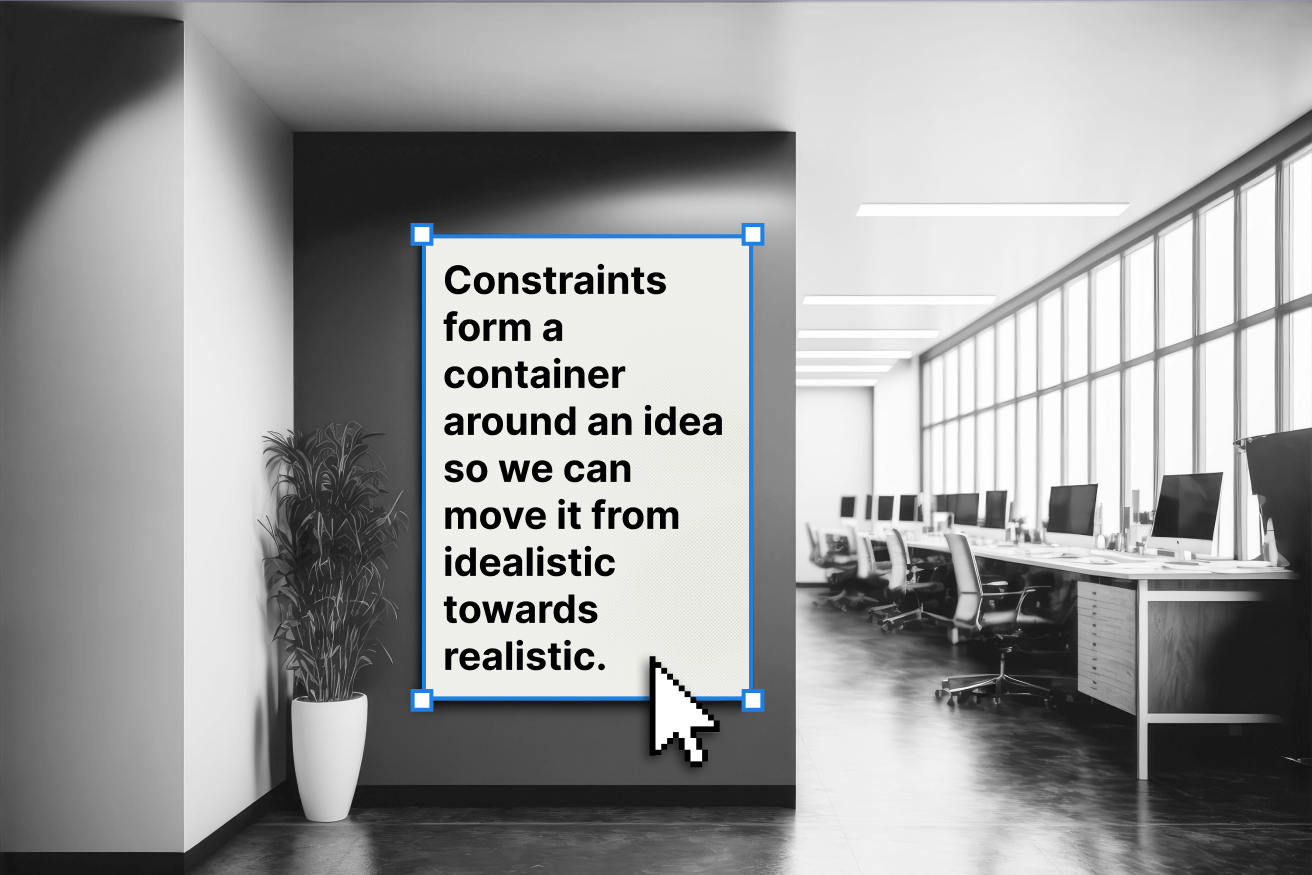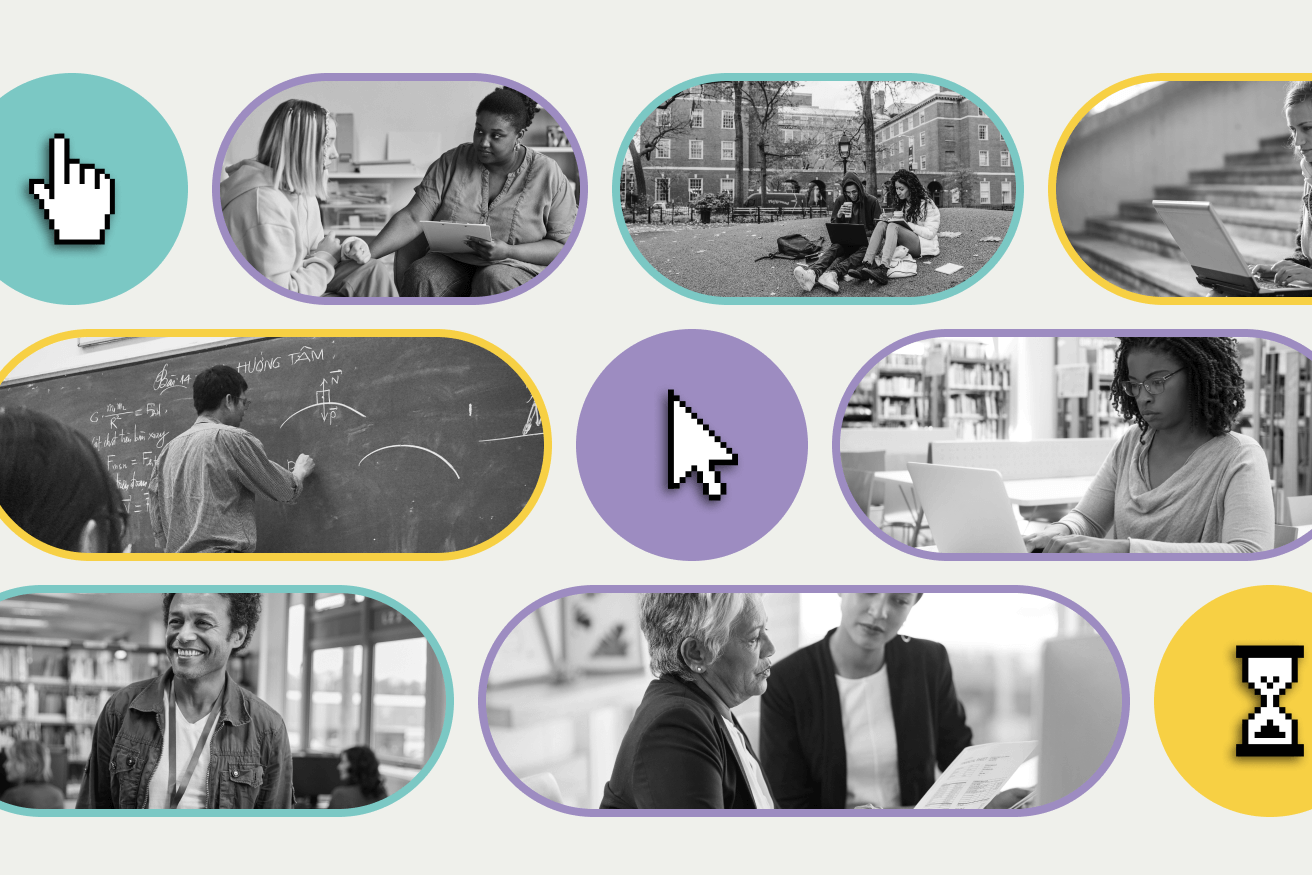Thoughts

Framing, To Get To Creative Constraints
The role of vision
Your creative team wants a reason to go to work, and as a creative leader, you need to provide the vision that Jobs describes. As an organization, we often spend time building mission and vision statements—short phrases that articulate the most high-level purpose of what we do. But without a creative vision, those statements often ring hollow or unbelievable.
The seeds of that creative vision often emerge from popular innovation frameworks, like lean’s business canvas or design thinking’s double diamond. These frameworks recommend that we suspend our skepticism of off-the-wall concepts so that we can move past incremental innovation to something groundbreaking. Coming up with these new ideas is like dreaming—we end with an idealized view of a new future. We imagine a new product or service in its best light because we view it optimistically. During the dream state of these innovation sessions, we imagine that our product is perfect and that we have the ability to deliver it. We tell stories of easier lives, a better world, and the financial benefits of a successful product-market fit.
For example, if we’re working in an educational-software company, we might tell a story of how our new product (that doesn’t yet exist) miraculously fixes the broken education system and makes our business successful. Imagine—
Our product helps students identify their passions and find majors they love. By selecting a perfect course of study, they can learn a series of practical skills while simultaneously developing critical thinking. They’ll graduate on time, and we’ll help them find a great job they love. We capitalize on this value promise by selling our product to schools, and we become the market leader in this solution area. Because the product is so effective in driving retention outcomes, we can charge a premium justified by the near-term ROI for a given customer. We quickly become the central system for integrating disparate technology platforms, locking customers into a controlled ecosystem. We can grow multiple new products on the platform and leverage the data produced in aggregate to create and sell insights through consulting services.
The paragraph seems pretty great, as if we’ve tackled and fixed all of the seemingly impossible problems in education. This dreaming is useful because it anchors and motivates the team and helps to challenge the status quo. Visualizing the perfect state helps produce the direction for a team to move towards and align around. Without this vision, what my teams call the “Barbie Dream House,” it’s hard to identify correct decisions and measure success.
Because the vision assumes perfection, it is purposefully naïve. It forces us to temporarily ignore core-business realities. It doesn’t need to account for budget constraints, technological limitations, political team dynamics, quarterly profits, time, and any of the other things that make a business a business.
But even while that idealized future motivates, the lack of realism can trigger anxious questions. How will we get there if we aren’t properly equipped? How will we overcome the technical complexities of the vision? And if we don’t have the right skills and capabilities, who will get us there?
It’s tempting to try to answer these questions before knowing what that vision actually is. And it’s hard to craft that vision when no clear boundaries exist yet to show us even what problem we’re solving. To deal with the resulting anxiety, we often try to minimize risk: We back away from the beauty and perfection of the new idea. Our overly idealized future solves a problem, but because we aren’t sure it’s the right problem, we limit ourselves.
To feel that we are solving the right problem, we need a way to give the problem form.
Creative constraints are the way to frame the problem space, allow for exploration, and bring an idealized vision of the future into a more practical, approachable reality. Constraints form a container around an idea so we can move it from idealistic towards realistic. That container acts as a set of rules. Although you might think of rules as stifling, they aren’t. In fact, the process of making things flourishes within creative constraints. For creative people in particular, constraints are one of the most valuable thinking tools.

Creative constraints support innovation for two reasons. First, unlike requirements, constraints are flexible. They can shift as innovations push the boundaries of traditional “appropriate” thinking, and as they shift, the creative process can follow. Second, constraints often emerge from the creative exploration itself. That means the creative team has ownership over the boundaries, not just the solution.
We’ve all had the “Aha!” experience while we work through a problem: We suddenly see the problem clearly from a new perspective. Constraints emerge from these mini moments. We create them during the creative process, leverage them during exploration, and evolve or abandon them as the fidelity and detail of an idea changes. And when you look at that elusive question—”what are we building?,” constraints start to point to answers. They provide a way to say “this, but not that”; they provide the product framing.
Understanding framing
Framing describes the perspective you take during any situation. The cognitive-psychology theory of framing states that people interpret their experiences through a lens informed by their life experiences. This happens naturally and continuously—it’s how we make sense of the world. The trouble is that, while any particular frame reveals new and interesting content, it also serves to conceal some information. With any given frame, we may miss an opportunity that might have been obvious if we had looked through a different frame. Think of this as a perspective bias: We always have a one-sided view of a situation based on the lens we choose.
We typically think of a bias as a bad thing. But once we understand how framing works, we can use perspective bias to our advantage. We can become more aware of our active frame by considering the assumptions we are making about a given event, experience, action, or activity. And that awareness allows us to shift around the frame. We can even reframe a situation, to view it from another perspective.
Let’s come back to our higher-education example. Are you reading in the news about the inflated costs of academia and getting more and more worked up about poor graduation rates and sky-high student debt? It’s easy to be the armchair quarterback: Why don’t they just get better teachers? Why don’t they just lower the cost of tuition? Why don’t the students just work harder?
Now imagine that situation from the perspective of the academic deans who have to manage decreasing budgets under more and more scrutiny. Instead of judging these deans, try to visualize the situation from their point of view: Consider what their perspective on life might be, why they have their job, what motivates them to work every morning, what they think of you, what they think of the policies they have to follow, and so on.
Now imagine a student, taking a test in a required sophomore chemistry class, and the other people involved in the experience: the proctor, who administers the exam; the teacher’s assistant, who helped to prepare the student for the test; the instructor, who taught the student, developed the curriculum and the test, and who will grade the test. If you shift your frame of reference, you zoom out from the topic to see a relationship even to the parents, the academic dean, and potential employers. All of these people are looking at an objective reality: a student took a test in a specific way.
Because we don’t have the benefit of omniscience, our perspective is shaped by the emotional impact and contextual information we have about the experience. If the student does poorly but had attended office hours, the instructor may empathize and be more lenient on grading that exam. The parent may direct frustration over a poor score into anger at the student. And that same score might demoralize the student enough to drop the class.
Each participant in the objective event has a subjective view of it, often limited by individual experience. In each case, that view puts a box, built from past experience and personal knowledge, around what really happened. The box acts as the initial constraints of understanding.
Additionally, each participant views that event and subsequent events through a lens that distorts reality. That distorted lens so dramatically influences what we think happened that it becomes a new reality, at least for that participant.
Framing in problem solving
When confronted with a new creative problem, creative teams have learned that the initial boundary conditions are rarely the real rules of the road. They’re only the first frame. So to establish a larger and richer idea space, the teams have also learned to reframe a problem to view these conditions through as many lenses as possible.

Articulating these boundary conditions and lenses fosters creativity. After marinating in the mess of constraints, we’ll synthesize the boundary conditions into a single framing statement.
Imagine that you're working in a fictional educational software company that’s entering the market with a new product offering. You're in our product-kickoff meeting. As the CEO, customers (primarily school superintendents and principals) tell you over and over that students aren’t prepared to succeed in college. You’ve reflected on this statement, and in meetings and in conference calls within your company, you’ve been trying on the phrase “student success.” This idea emerges as the first problem frame: an opportunity exists to help students succeed in their journey from high school to college. Although that statement frames the problem at a high level of abstraction, it forms some of the initial constraints for creative problem solving. Look at all it encapsulates:
- We’re creating something for students.
- We’re creating something to help students transition from high school to college.
- We’re creating something for people who go to college.
- We’re creating something for success, although we haven’t defined success yet.
Let’s explore product framing from the perspective of a given person, rather than a product landscape. Consider the map of all of the people whom our yet-to-be-created product could positively influence along with their perspectives, wants, and needs:
| Person | Emotional characterization | Implications of that perspective | Framing statement |
|---|---|---|---|
| Students | nervous, anxious, expectant |
| We are designing new features in our homework product to help students gain enough confidence to make informed decisions about their future. |
| Instructors | optimistic in general, but somewhat resigned to the fact that not everyone will succeed |
| We are designing a new product to give instructors the time to help all students plan for the future. |
| Guidance Counselors | committed to success, but frustrated with the mechanized system of college admissions; overwhelmed by the quantity of students requiring help |
| We are designing a new suite of products to find out about students’ aspirations and help guidance counselors create individualized plans for each student. |
| Parents | overwhelmed by choices |
| We are designing a new product to help parents narrow college choices to just a few. |
| Admissions Officers | overwhelmed by candidates and incoming questions from parents |
| We are designing a new product to help admissions officers make fairer decisions. |
We’re identifying all four columns—the people, their emotional characterization , the implications of those emotions, and the frame itself—based on our own knowledge and experience. Design thinking enables customer research that helps us build empathy with audiences as it shapes our understanding of various frames. That type of research acts as a sort of hedge, so we can be more confident in the types of generalizations we make.
The “implications” column is the most important. It predicts behavior and starts to address how someone will respond to a new idea, product, or service. It’s also the biggest leap from our own point of reference because it demands that we jump out of our comfort zone. Once you establish implications, the frame naturally follows.
Notice how the frame now makes judgment easier. It’s easy to look at creative solutions and say, “yes, this does that” or “no, this doesn’t do that.”
We’re just at the beginning of the creative process, but each initial frame we select at this stage will color what we do next. The framing statement creates a starting point for creative exploration, for user research, for market sizing, and for business model canvassing.
The initial frame can’t be wrong because it’s shaped by each team members’ perspective. We automatically start with a frame built on our own experiences, remembering what it was like to be a student, or leveraging conversations we had with our child’s teachers. But because our perspective is unique, the initial frame is the first opportunity for misalignment in our team. Each team member’s unique frame of reference leads to a different view of the problem being solved. That means initial, and subsequent moves will probably go in different directions. It’s critical that the team is aware of the selected frame and that it realigns around a purposeful reframing of the problem.
Takeaway: Write each active frame, in large letters, where the team can see it. Rewrite it each time it changes. To derive implications and emotional characterizations, work through all potential frames in order.

